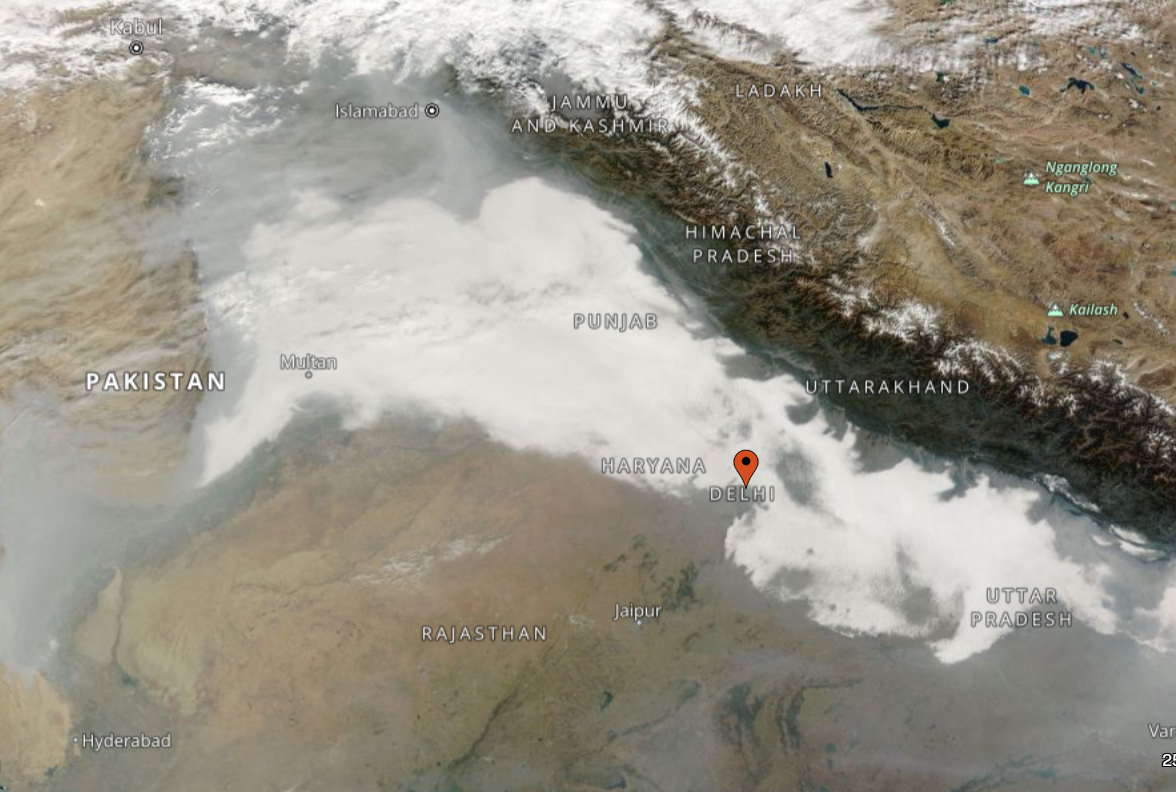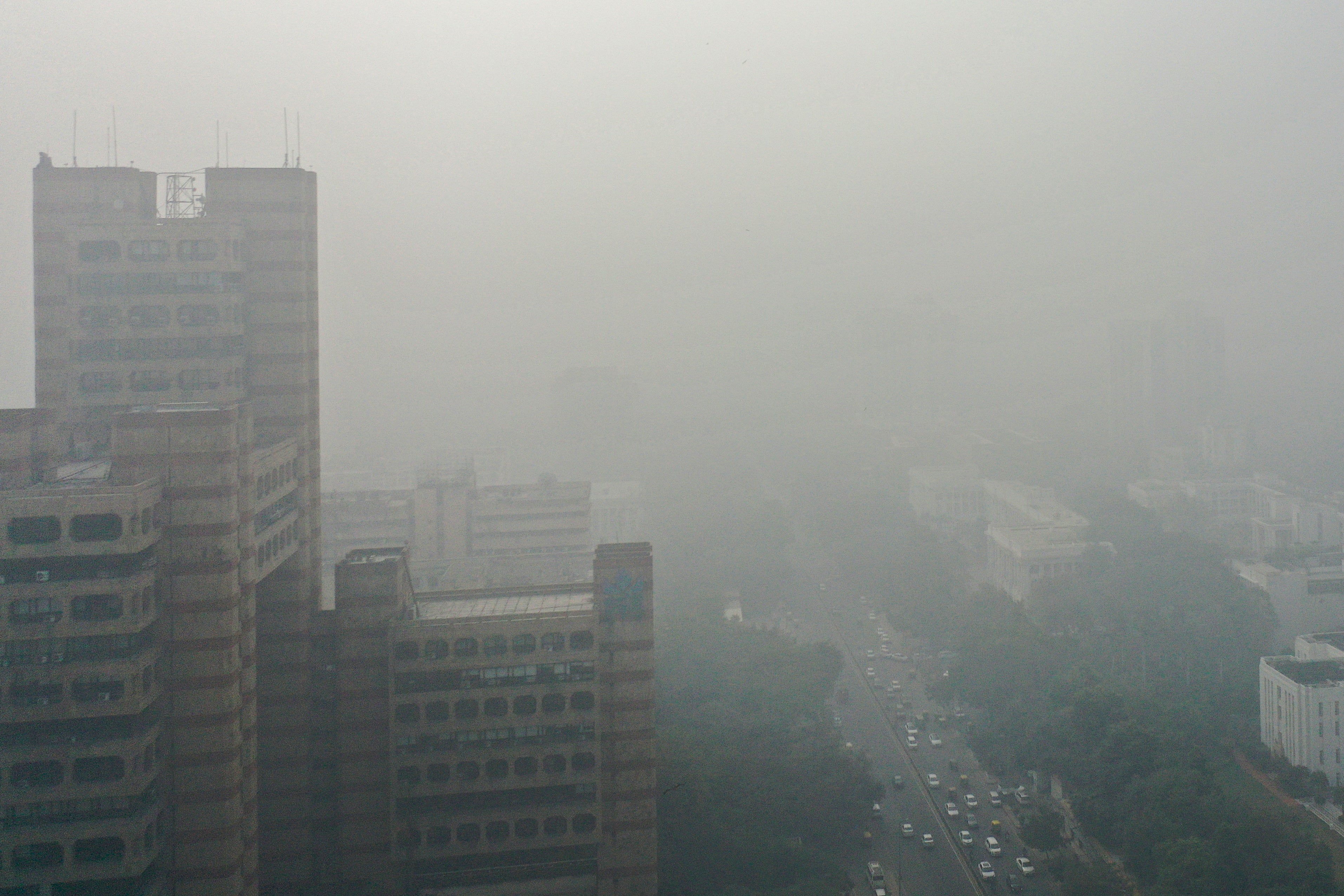Delhi smog visible from space as air quality ranked ‘severe’ for second day running
The Taj Mahal on Thursday disappeared in the grey hazy cover of thickening smog
The toxic smog engulfing Delhi was visible from space as satellite images captured the Indian national capital’s “severe” air pollution crisis continuing for two consecutive days.
Historical landmarks of northern India, such as the Taj Mahal and India Gate, disappeared in the grey hazy cover of thickening smog as the region battled high pollution, humidity, low wind speed and a drop in temperature.
Northern India encountered the recurring annual pre-winter event of air emergency where the Air Quality Index (AQI) readings of main pollutant PM 2.5 breached the 400-mark of “very poor” and landed the air of Delhi, Punjab and other northern cities into the “hazardous” category.
Satellite images taken from the Nasa worldview map drew a sharp contrast between the skies over northern India just 50 days back and on Thursday as residents woke up to a blanket of smog.


An image taken on 1 October showed comparatively clearer skies over India and Pakistan as the region’s air quality slowly plummeted. The images taken this week, on Wednesday and Thursday, confirmed the plains, running parallel to Himalayan belt, went missing under a thick blanket of white and yellowish coloured smog visible from space.
Authorities in Delhi ranked the pollution as “severe” for the second day in a row, with a reading of 430 on the AQI maintained by the top pollution body.
India’s Central Pollution Control Board (CPCB) regards AQI between zero and 50 as "good", 51 and 100 "satisfactory", 101 and 200 "moderate", 201 and 300 "poor", 301 and 400 "very poor", and 401 and 500 "severe", and unfit for any outdoor activities. Delhi slipped into “severe” AQI zone on Thursday morning with a reading of 430.


The earth sciences ministry said the pollution levels in the city and its neighbouring regions will remain “severe” on Friday as well.
“Coming back to Delhi from Wayanad where the air is beautiful and the AQI is 35, was like entering a gas chamber. The blanket of smog is even more shocking when seen from the air,” said Indian politician from opposition Congress party, Priyanka Gandhi.
“Delhi’s pollution gets worse every year. We really should put our heads together and find a solution for cleaner air. It’s beyond this party or that, it’s practically impossible to breathe especially for kids, elders and those with respiratory issues. We just have to do something about it,” she said on X.
The main causes behind Delhi’s deadly air crisis are vehicular pollution, dust, emissions, construction pollution and smoke from farm fires burnt in neighbouring states Punjab and Haryana. The crisis multiplies around October and November owing to two factors of – large-scale burning of firecrackers on Diwali and dip in temperatures due to onset of winters.

The minimum temperature in Delhi fell to 16.1C on Thursday from 17C the previous day, weather officials said.
The pollution has drastically impacted visibility in the region as the visibility dipped to 300m (980ft), said the Delhi International Airport Limited. Top airlines also warned of delayed flight operations.
New Delhi’s international airport diverted some flights on Wednesday.
Environment experts have expressed anger at the slow death disguised as hazardous air pollution levels that they say have been normalised in the country. The AQI readings a day earlier showed more than 1,000 by Swiss IQAir, a different metric to map air quality across the world.
The AQI of 581 by Swiss IQAir on Thursday, measuring the levels of inhalable particulate matter PM2.5, that can cause serious respiratory ailments, was at least 73 times more than the safe limit prescribed by the World Health Organization.

“If we go by even the 400-500 reading, that in itself is an emergency and should call for a shutdown of a city in any sane world. This AQI has led to cities being evacuated but here in Delhi, as usual, we have not heard a single word from the authorities,” said Indian environmentalist Vimlendu Jha, seeking a proactive plan from the government.
The prominent air activist said that Thursday marked Delhi’s 15th straight day of “very poor” air quality and “the last two days have been “severe” because the wind direction is no longer favourable”.
“While Delhi does suffer from the trapping geographical disadvantage or reality, and year after year waits for strong winds, that does not mean the pollution has reduced or stopped. Pollution hasn’t reduced the wind, it just takes it away to another place,” he told The Independent.
The numbers of AQI readings were allegedly being manipulated by installing water sprinklers next to monitoring stations, Indian news agencies reported. “The AQI reading is going to be 50 per cent less if the numbers are managed notoriously in that manner,” said Mr Jha.
“The situation only will get worse now for the next two days, although the Commission for Air Quality Management (CAQM) has called this an episodic event rather than actually taking any constructive measure or initiating a plan. We don’t know if the wind direction in the coming days will clear out the pollution but the air quality governance is in the hands of weather gods in that sense,” he said.
Join our commenting forum
Join thought-provoking conversations, follow other Independent readers and see their replies
Comments
Bookmark popover
Removed from bookmarks